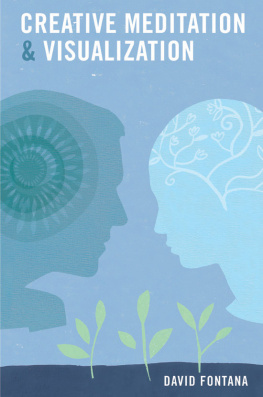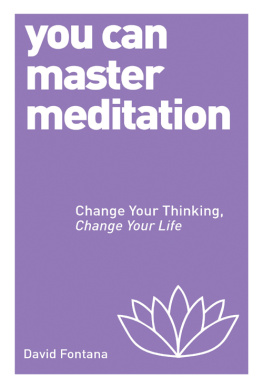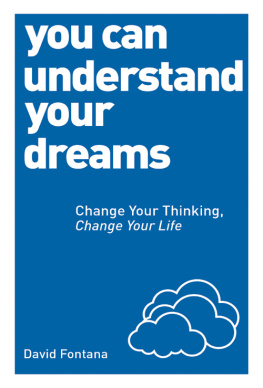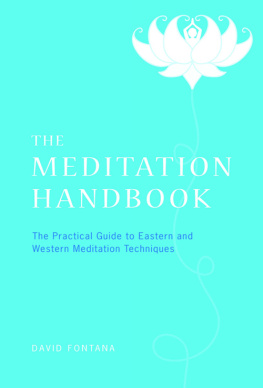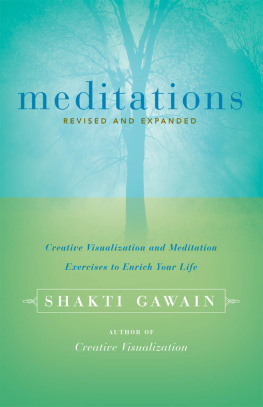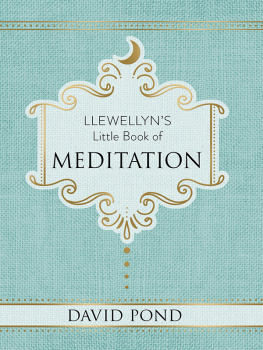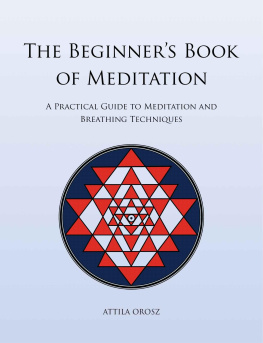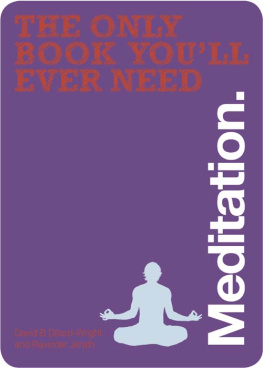David Fontana - Creative Meditation & Visualisation
Here you can read online David Fontana - Creative Meditation & Visualisation full text of the book (entire story) in english for free. Download pdf and epub, get meaning, cover and reviews about this ebook. year: 2012, publisher: Watkins Media, genre: Religion. Description of the work, (preface) as well as reviews are available. Best literature library LitArk.com created for fans of good reading and offers a wide selection of genres:
Romance novel
Science fiction
Adventure
Detective
Science
History
Home and family
Prose
Art
Politics
Computer
Non-fiction
Religion
Business
Children
Humor
Choose a favorite category and find really read worthwhile books. Enjoy immersion in the world of imagination, feel the emotions of the characters or learn something new for yourself, make an fascinating discovery.
- Book:Creative Meditation & Visualisation
- Author:
- Publisher:Watkins Media
- Genre:
- Year:2012
- Rating:5 / 5
- Favourites:Add to favourites
- Your mark:
- 100
- 1
- 2
- 3
- 4
- 5
Creative Meditation & Visualisation: summary, description and annotation
We offer to read an annotation, description, summary or preface (depends on what the author of the book "Creative Meditation & Visualisation" wrote himself). If you haven't found the necessary information about the book — write in the comments, we will try to find it.
Creative Meditation & Visualisation — read online for free the complete book (whole text) full work
Below is the text of the book, divided by pages. System saving the place of the last page read, allows you to conveniently read the book "Creative Meditation & Visualisation" online for free, without having to search again every time where you left off. Put a bookmark, and you can go to the page where you finished reading at any time.
Font size:
Interval:
Bookmark:
Dr David Fontana is the author of over 40 books on psychology, meditation, dreams, spirituality and psychical research that have been translated into 26 languages. His publications include The Secret Language of Symbols, The Secret Language of Dreams, The Meditators Handbook, Learn to Meditate, Psychology, Religion and Spirituality, and most recently Is There an Afterlife? He is a PhD in psychology, a Fellow of the British Psychological Society, and a Past President of the Society of Psychical Research. Formerly Distinguished Visiting Fellow at Cardiff University, he is the first Professor of Transpersonal Psychology to be appointed in the UK. David Fontana has studied and practised meditation for over 30 years, working with leading teachers from many countries and traditions, and has been a frequent broadcaster on radio and television.
A Selection of Books by David Fontana
The Secret Language of Symbols
The Secret Language of Dreams
Meditating with Mandalas
The Elements of Meditation
The Lotus in the City
Know Who You Are, Be What You Want
Growing Together: Parent-Child Relationships as a Path to Wholeness and Happiness
Your Growing Child
Learn to Meditate
Learn Zen Meditation
The Meditators Handbook
Meditation Week by Week
Psychology, Religion and Spirituality
Is There an Afterlife?
DAVID FONTANA

Publishers Note: The information in this book is not intended as a substitute for professional medical advice and treatment. If you may be suffering from psychological problems you should not practise meditation or visualization without first taking appropriate medical advice as to their suitability for you and it is recommended that you consult a medical professional before following any of the advice or practice suggested in this book.
Watkins Publishing, or any other persons who have been involved in working on this publication, cannot accept responsibility for any injuries or damage incurred as a result of the following the advice contained in this book.
This book describes and explains how to use one of the most important powers of the human mind, visualization. The mind is a wonderful instrument, surely among the most wonderful in creation, and it is a sad fact that very few of us make use of even a small part of its potential. We often hear (and probably use) the phrase mind over matter, yet to what extent do we really believe that mind can influence matter, that the mind by taking thought can affect the body and the things it is able to do?
Why is it that we neglect the power of the mind to such an extent? There are two main reasons. Firstly we are never taught how to use this power. The Western educational system is a wonderful tool for conveying information to children and young adults, but at no point does it devote any part of the curriculum to the way in which our own minds can bring benefits to our own bodies. Secondly, Western science has typically either taken little interest in the mind-body relationship, or has actively dismissed its importance. For example, it is only very recently that the medical profession has begun to accept that at least a third (and maybe significantly more) of physical illnesses have their origins at least partly in the mind. The same profession has just started to recognize the power of the mind to heal the body, even though what is now called the placebo effect the fact that if you believe something is doing you good then there is fair chance that it will has been demonstrated by the medical professions own experiments for very many years. And it is even more recently that the same profession, together with the psychology profession, has begun to recognize that visualization is one of the most effective ways in which this mental power can be harnessed to best effect.
Visualization is in fact an important tool not only for assisting healing but for enhancing human performance in a wide range of areas, from sport to creativity and from social success to career advancement. This book looks at these areas and also links visualization to another power of the mind, neglected until recently by Western science, namely meditation. Visualization and meditation are not the same thing but they are closely related and can be used in harmony and conjunction with each other, particularly as visualization becomes even more effective if it is practised as a form of meditation. Meditation is about calming and quietening the mind, so that instead of being continually distracted by the chatter of its own thinking (much of it, we have to admit, of very little consequence) it becomes clear and open, a state in which it is much more effective in relaxing the body, in dealing with stress, and ultimately in gaining insights into its own deeper nature. Meditation practices differ in detail, but all are based upon giving the mind a stimulus such as the breathing on which it focuses steadily and to which it returns each time thoughts intrude and threaten to cause distractions. When combining meditation with visualization, the meditator uses visualized images as the stimulus, whether these have to do with healing, with remaining calm in stressful situations, or with any one of the many other activities with which visualization is helpful. Meditation also helps develop powers of concentration, so that the mind becomes more effective in holding onto visualized images more clearly and consistently whenever they prove helpful in daily life. And the better the concentration, the more likely it is that these images will bring results.
Naturally enough, visualization and meditation are not panaceas for all the challenges some unwelcome, others welcome and freely chosen with which life presents us (no such panaceas exist in this world) but visualization and meditation add a new and very effective dimension to life at both psychological and physical levels, and do so, moreover, at no cost apart from the expenditure of a little time and commitment. Results are, of course, not necessarily apparent overnight. Both visualization and meditation are natural activities of the mind but the great majority of us have allowed them to fall into disuse. In most cases we employed them better as children than we do now. We have to relearn our own skills, and like any learning this can take a little time. But it is not only time well spent, it is time that brings new and exciting discoveries about our own minds and about ourselves. The human mind is one of the most wonderful instruments in creation and one of the most interesting and most magical. Our mind is essentially where we live, and the link between our spiritual and our physical selves. Each of us must decide for him or herself why the mind should possess such riches when we normally only use and indeed only discover a small percentage of them, with the result that we go through much of life as partial strangers to ourselves. Visualization and meditation can take us deeper into these riches, and give us practical tools for enhancing life and making us more effective at all levels of our being.
Chapter 1
What is Visualization and Why does it Work?
Visualization and Imagination
The word visualization (sometimes referred to as imagery) suggests that we are talking about imaginary scenes that we picture in the minds eye and so we are, but there is much more to it than this. When asked to visualize, many people are indeed able to see things in the minds eye when they close their eyes, but others simply become aware of impressions and of thoughts that have to do with pictures rather than seeing the pictures themselves. Yet others report that they can see visualizations even when their eyes are open, as if these visualizations are viewed by the so-called third eye (said to be situated just above and between the physical eyes) and exist simultaneously with what is seen at the same time with normal vision. Each of these experiences can nevertheless be classed as visualization, and it is useful to try visualizing now for a moment to see which of them is true for you. Since this is your natural method of visualizing it is good to use it in all your visualization practice, at least until you have fully mastered the technique.
Next pageFont size:
Interval:
Bookmark:
Similar books «Creative Meditation & Visualisation»
Look at similar books to Creative Meditation & Visualisation. We have selected literature similar in name and meaning in the hope of providing readers with more options to find new, interesting, not yet read works.
Discussion, reviews of the book Creative Meditation & Visualisation and just readers' own opinions. Leave your comments, write what you think about the work, its meaning or the main characters. Specify what exactly you liked and what you didn't like, and why you think so.

